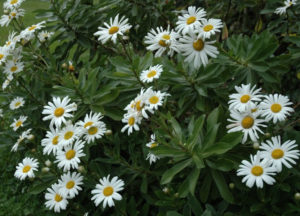Montauk daisy
* Common name: Montauk daisy (Nippon daisy)
* Botanical name: Nipponanthemum nipponicum
* What it is: A nearly 3-foot-tall perennial flower that’s one of the last of the season to bloom, usually starting in late summer and continuing past the first light fall frost.
Flowers are daisy-like with white petals and yellow centers. Montauk daisies closely resemble tall mums and were once classified in the chrysanthemum family.
Native to China and Japan, these have naturalized through much of the eastern U.S.
* Size: 3 feet tall. Space 2 to 2½ feet apart.
* Where to use: Perennial borders, cut-flower gardens, south- or west-facing foundations, pollinator gardens (they’re a late-season food source for butterflies), or any sunny bed or bank. Full sun yields best bloom.
* Care: Keep damp the first season, then water usually is not needed, except in prolonged drought. Avoid planting in wet soil or shade.
Scatter an organic granular fertilizer formulated for flowers over the bed in early spring.
To keep plants from flopping over from weight of the flowers in fall, cut whole plants back by half in late May. A second lighter clipping also can be done at the end of June. Or figure on staking the plants if you like them tall.
Cut back foliage to the ground at the end of winter. Clumps can be dug, divided, and replanted in early spring.
* Great partners: Other late-blooming fall perennials combine to make a nice fall garden, including asters, mums, and goldenrods. Red switchgrass and Indian grass make good native-grass textural contrast. Interplant with golden daffodils for early-spring color until Montauk daisies get growing.







